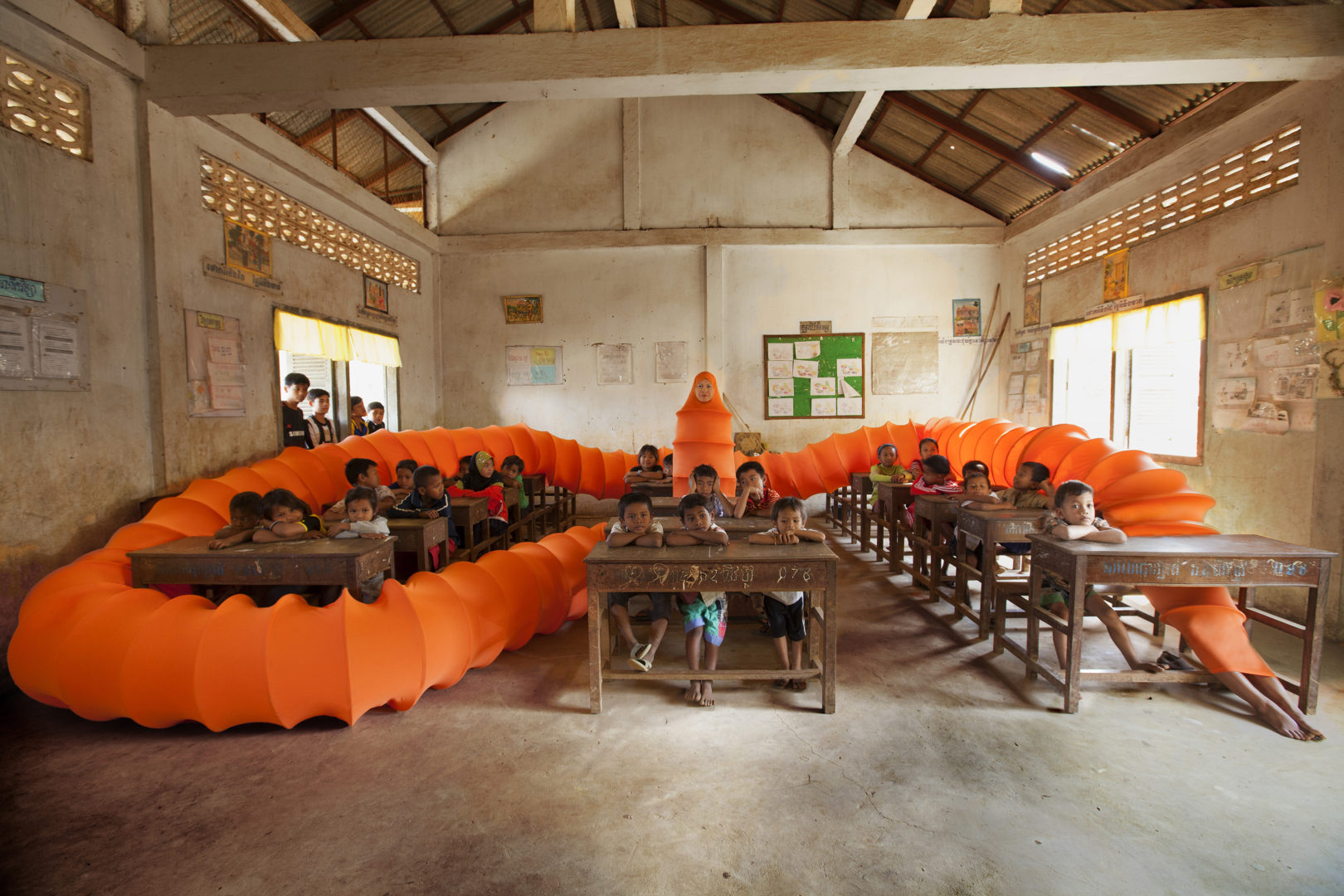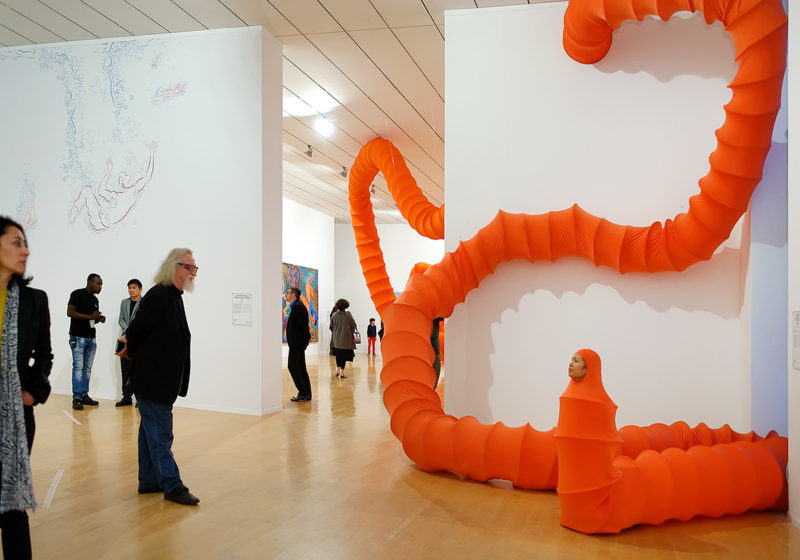diaCRITICS highlights Vietnamese and Southeast Asian artists and writers of the diaspora. This is Part 1 of a two-part artist profile of Anida Yoeu Ali, who is of mixed Khmer-Thai-Malay-Cham lineage, born in Cambodia and raised in Chicago. Read a Q&A with the artist in Part 2 of our profile.

1.
this place is a home
unknown, yet familiar still
displaced is a home
I have been fortunate enough to return to Cambodia after 30 years of absence to realize The Buddhist Bug series and other artistic projects. It is poetic that I would return as an adult to live and work in Cambodia for exactly 5 years, the same amount of time I had spent as a small child before my family fled as refugees from the Khmer Rouge. I have been chasing those 5 years of my childhood, haunted by fractured memories and wondering who I would have been had we not been forced to leave. I have come to realize we didn’t choose to leave, the leaving chose us. This shift in thinking about our exodus has empowered me to heal and make meaningful art. As a diasporic artist, I can’t help but excavate themes related to body memories, belonging, and fractured identities. Growing up as a refugee in the U.S, and raised in a traditional Muslim Khmer household, I continued to struggle with issues of assimilation and belonging – struggling between multiple identities and not yet understanding the powerful role of intersectionality nor of hybridity. The Buddhist Bug is my most ambitious body of work, a creation myth sprung from my interest in hybridity, transcendence, and otherness.

2.
orange/tangerine
both a bridge and a tunnel
across and over
The Bug is a fantastic saffron-colored creature that can span the length of a 100-metre bridge or coil into a small orange ball. Rooted in both imagination and autobiography, The Bug provokes obvious questions of belonging and displacement. Inspired by my own spiritual turmoil between Islam and Buddhism, each vignette presents a moment of real life with the element of The Bug making each frame more surreal and provocative. Some of these vignettes are nostalgic ruminations dissecting the diasporic dilemma, one that is caught between memory and reinvention. Created from a sense of play, The Buddhist Bug series utilizes a unique combination of humor and otherness. For me, this ongoing project reflects my personality, one that combines humor, performance, science fiction and my love of everyday culture into moments that transcend the ordinary.

3.
my reinvention
from the past before the last
breath is turmoil
Captured and exhibited primarily as photography, video, and performance-installations, my interdisciplinary approach maps new political and spiritual landscapes. Meters and meters of textile act as skin, as a way for the surface of my body to extend into public spaces, and as a metaphoric device for stories to spread across an expanse. For me, The Bug is a displaced creature destined to travel and wander amidst the “in-between”. This space, which exists between who s/he is and where s/he is, is in fact a powerful place for encounter, habitation and reinvention.
The Bug is an assertion of paradoxes, a result of a hybrid refugee experience, embodying the fluctuating inside/outside perspective of the transnational being. S/he longs for stillness while on a constant journey. S/he is a source for refuge while on a perpetual search for home. S/he is both a bridge and obstacle. S/he is a creature belonging in this world yet appearing to be from another universe.
4.
the skin s/he sits in
wraps around like loose virtues
haram halal truths
At the heart of my work is an interest in developing stories, usually narratives that exist outside of conventions. The Buddhist Bug continues a methodology in which personal narratives shape my art. I believe performing narratives is an act of social engagement that contributes to collective healing. For me, performance and storytelling become ways of bridging the interior and exterior space of self as well as initiate critical dialogues between communities and institutions. From daylight to nightfall, inside classrooms and outside amusement parks, along stairwells and street corners, The Bug appears— present, visible, and curious. I have never been able to quietly create works inside a studio space, that is a luxury I have never had. Instead my works are performances taken into the streets and rice fields, classrooms and hawker stands— energetic sites where everyday people and daily life occur. Only after these site-specific performances, does the work return as photographic or cinematic artifacts—works of art that are then shared inside and outside of Cambodia. Set intentionally amongst school children, an oxcart driver, a Muslim fishing village, and random people in a busy alleyway, my works engage everyday people in an effort to include them into conversations rarely afforded them in the context of contemporary art. It is my hope that as The Buddhist Bug exhibition travels, people will catch a curious glimpse of a contemporary Cambodia they do not expect to see, one that is shaped by complexities, imagination and performance!
I am thrilled to have returned as an artist creating not only new memories but new art and contributing in significant ways to a re-emerging Khmer society, one that includes narratives inside and outside of the country, ultimately remapping the distance I’ve been chasing between here and there.

5.
between here and there
is a distance unchartered
saffron sea unfolds
——————————————
Current & Upcoming Exhibitions by Anida Yoeu Ali
A two-month solo show of The Buddhist Bug: A Creation Mythology just finished at Wei-Ling Contemporary in Kuala Lumpur, Malaysia. This exhibition contained the entire collection of images, videos and text created for The Buddhist Bug project from 2009-2015, including some images that had never been publicly exhibited. The project began conceptually in 2009 in Chicago and was not fully realized until Ali took residency in Cambodia from 2011-2015. The work has since been exhibited internationally with live performances in Cambodia, Singapore, Lithuania, Japan, France, Taiwan, and now Malaysia.
+
Ali’s work is currently on view at Haus der Kunst in Munich until Sept 29, 2019 as part of Archives in Residence: Southeast Asia Performance Collection Exhibition.
+
Ali and her collaborating partner, Masahiro Sugano, will be artists-in-residence at Shangri La Museum of Islamic Art, Culture and Design from Nov 7-17, 2019 in Honolulu. Ali: “This commissioning residency will be the beginning of a long process to rebirth and re-envision The Red Chador performance, the work that was taken from me in Tel Aviv. Our residency begins with a collaborative program with the American Studies Association annual conference.”
+
Group Exhibitions:
“Modest Fashion” at Stedelijk Museum Schiedam, Sept 21, 2019-Feb 9, 2020 (Schiedam, The Netherlands)
“Shaping Geographies: Art | Woman | Southeast Asia”, Nov 23, 2019-Jan 5, 2020, at Gajah Gallery (Singapore)
“Periphery” Biennale Jogja XV, Oct 20-Nov 30, 2019, at Jogja National Museum (Yogyakarta, Indonesia)
Artist Bio
Anida Yoeu Ali (b.1974, Cambodia) is an interdisciplinary artist whose works span performance, installation, new media, public encounters, and political agitation. Raised in Chicago and born in Cambodia, she is a woman of mixed heritage with Malay, Cham, Khmer and Thai ancestry. Utilizing an interdisciplinary approach to artmaking, her installation and performance works investigate the artistic, spiritual and political collisions of a hybrid transnational identity. Ali is the winner of the 2014-2015 Sovereign Asian Art Prize for her series The Buddhist Bug, a multidisciplinary and internationally recognized work that investigates displacement and identity through humor, absurdity and performance. No stranger to controversy, in 2018 Ali announced the “death” of the Red Chador, a public intervention series highlighting Islamophobia, after returning to America from Ramallah, Palestine without the luggage containing the one-of-a-kind performance garment. Ali has performed and exhibited at the Haus der Kunst, Palais de Tokyo, Musée d’art Contemporain Lyon, Jogja National Museum, Malay Heritage Centre, Fukuoka Asian Art Museum, The Smithsonian, and Queensland Art Gallery. Her artistic works have been the recipient of grants from the Rockefeller Foundation, Ford Foundation, the National Endowment of the Arts and the Art Matters Foundation. Ali’s pioneering poetry work with the critically acclaimed performance group I Was Born With Two Tongues (1998-2003) is archived with the Smithsonian Asian Pacific American Program. Currently based in Tacoma, Ali is also the co-founder of Studio Revolt, an independent artist run media lab whose works have agitated the White House, won awards at film festivals, and has redefined what it means to create sans-studio and trans-nomadically. Ali holds an MFA from School of the Art Institute Chicago (2010) and a BFA from University of Illinois, Urbana-Champaign (1998). Ali currently serves as an Artist-in-Residence at the University of Washington, Bothell where she teaches courses in Interdisciplinary Arts, Global Studies and American & Ethnic Studies. She spends her time traveling and making art between the Asia-Pacific region and the US.


